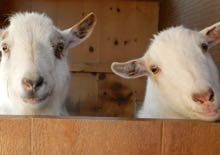This is not a pretty topic, but just about everyone who has kept chickens has faced it at least once. Sunday night I got a call from a friend here in town. She’s kept chickens for thirty years, but just this week had her first experience with finding two hens pecked to death.
Chickens are omnivores. In storybooks they eat corn. Sometimes worms. In real life I’ve seen a hen gulp down a frog. They like cheese. And meat. Chickens are attracted to the color red. They’ll peck at anything that color, including each other. It doesn’t make them mean or vicious. It’s just who they are.
Chickens peck at each other all of the time. The term “pecking order” comes from flock dynamics. Chickens let each other know who has first dibs to the best food and the best roost by using their beaks. They rarely hurt each other. It’s simply how they communicate. But, sometimes something happens that upsets the equilibrium.
Yesterday, I went to my friend’s coop to solve the mystery of why her established flock now had hens with gaping wounds and one rooster shivering on a high roost.
The first thing to ask is “has anything changed recently?”
Here are the clues:
This winter two Wyandotte pullets were added to the flock of mostly Polish and cochins. Wyandottes are a tad more assertive than the other breeds already there. After a few minutes of observation it was obvious that the Wyandottes are pecking the other hens.
The weather has been awful – dark, rainy, cold. The chickens have been inside.
My friend used to let her chickens free range, at least part of the day, but the fear of coyotes (often visible in the fields) have kept the chickens confined to a small coop and fenced pen.
She owns two large roosters. Both are nice boys, not at all aggressive to people, but they are huge and active.
Only one of the hens shows a bare saddle area where the rooster has been mounting her (bare-backed hens are a sign of mating.) Roosters have favorites, and it looks like this poor hen was showing the signs of excessive male attention. That hen has been pecked severely.
What this all adds up to is that this flock, that is larger than normal, has been more confined than usual. Bored chickens peck. Once a hen has reddish bare skin showing, the other hens go after her.
The solution:
1. Give away the Wyandottes. Their personalities don’t mesh with the other hens. They might do fine in a different, free-ranging flock of large hens, or they might become stew.
2. Put duct tape on the bare back of the the pecked hen (duct tape should be in every farmer’s medicine cabinet!). By the time it falls off the feathers will be growing back in.
3. Any chickens with wounds need to be isolated in pens (dog crates work great), their wounds washed and topical antibiotics applied until healed. This is a pain in the neck to do, but necessary. (I once kept a pecked hen in the basement for 4 weeks. While there, I taught her some tricks, just for the heck of it. Chickens are easy to train. Remind me to blog about that…)
4. Give the chickens scratch grains (such as cracked corn) first thing in the morning to give them something to do. Get cabbage and kale (often supermarkets will give you boxes of trimmed leaves for free) and hang them up, or hang in suet feeders (see one in the inside hencam). Birds that have greens to peck rarely peck each other.
5. Sometimes chickens peck each other because they lack calcium in their diet. Add crushed oyster shell to the scratch.
6. If all else fails, reduce the size of the flock and expand the run. Rarely do chickens peck if they have enough space. (This is only true if all birds are healthy. Always remove sick or wounded birds immediately!)
My friend has some work to do, but I’m sure her flock will once again find a peaceful equilibrium.
